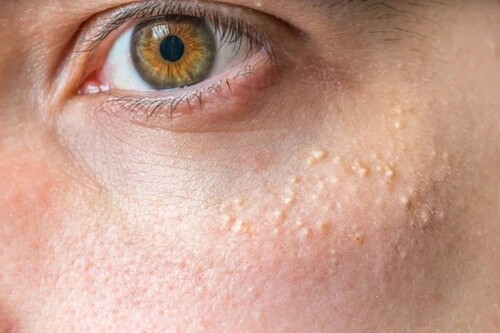Introduction tomilialar
Are you tired of dealing with stubborn skin issues? Do you find yourself constantly battling tiny bumps that seem to never go away? If so, then it’s time to dive into the world of milialar. This common yet often misunderstood condition can wreak havoc on your complexion and leave you searching for answers. But fear not! In this blog post, we will unravel the mystery surrounding milialar, exploring its causes, treatment options, and preventive measures. Prepare to gain a deeper understanding of this pesky skin concern and discover how to reclaim smooth and clear skin once again. So let’s get started on our journey towards milialar enlightenment!
What Causes milialar?
The exact cause of milialar is still unknown. However, several factors have been identified as potential contributors to the development of this condition.
One possible cause is genetics. It has been observed that milialar tends to run in families, suggesting a genetic predisposition. Certain gene mutations may play a role in the formation of milia-like cysts on the skin.
Another factor that may contribute to the development of milialar is damage to the sweat ducts or hair follicles. This can occur due to excessive sun exposure, burns, or trauma to the skin. When these structures are damaged, it can disrupt normal sweating and oil production, leading to the formation of small cysts.
Additionally, certain underlying skin conditions such as acne or rosacea may increase the likelihood of developing milia-like cysts. These conditions can affect the function and structure of the skin, creating an environment conducive for their formation.
It’s important to note that while these factors are believed to be associated with milialar, more research is needed for a complete understanding of its causes. If you suspect you have this condition or are concerned about your skin health, it’s best to consult with a dermatologist who can provide an accurate diagnosis and appropriate treatment options tailored specifically for you
Different Types of milialar
Milialar is a skin condition that can manifest in various forms. Understanding the different types of milialar is essential for proper diagnosis and treatment. While all types share common characteristics, such as the development of small bumps on the skin’s surface, they may differ in their underlying causes and specific symptoms.
1. Primary Milia: This is the most common type of milialar which occurs due to keratin buildup beneath the surface of the skin. It typically appears as small, white or yellowish cysts around the eyes, nose, cheeks, and forehead.
2. Neonatal Milia: As its name suggests, this type affects newborn babies. Neonatal milia often resolves without any intervention within a few weeks or months after birth.
3. Secondary Milia: Unlike primary milia that develops spontaneously, secondary milia arises from an underlying condition or injury to the skin like burns or blisters.
4. Multiple Eruptive Milia: This rare form involves clusters of tiny bumps appearing simultaneously over several areas of the body.
5. Traumatic Milium: Occurring after physical trauma to the skin like dermabrasion or laser resurfacing treatments, traumatic milium appears as single lesions at sites where injury occurred.
It’s important to note that accurate diagnosis by a healthcare professional is crucial in determining which type(s) one might have since some conditions may mimic milialar but require different treatment approaches.
Symptoms and Diagnosis of milialar
Milialar is a skin condition that can manifest in various ways, making it important to be aware of the common symptoms. The most noticeable symptom of milialar is the presence of small, white or yellowish bumps on the skin. These bumps are usually painless and may appear on the face, neck, chest, or other parts of the body.
In some cases, these bumps may be accompanied by redness or inflammation around them. This can make them more noticeable and cause additional discomfort for those affected by milialar. It’s worth noting that these symptoms can vary from person to person, so it’s essential to consult with a dermatologist for an accurate diagnosis.
When diagnosing milialar, dermatologists typically perform a visual examination to identify the characteristic appearance of the bumps. They may also inquire about medical history and any underlying conditions that could contribute to milia development.
In certain cases where there is doubt about the diagnosis or if further investigation is needed, a biopsy might be recommended. This involves removing a small sample of tissue from one of the bumps for laboratory analysis.
Recognizing and understanding these symptoms can help individuals seek appropriate treatment early on and better manage their condition. Early intervention often leads to more effective outcomes when managing milialar-related concerns.
Treatment Options for milialar
When it comes to treating milialar, there are several options available that can help alleviate symptoms and improve the overall condition of the skin. The specific treatment approach may vary depending on the severity of the milialar and individual factors such as age and overall health.
One common treatment option is topical creams or ointments that contain ingredients like retinoids or salicylic acid. These medications work by exfoliating the skin and unclogging pores, which can help reduce the appearance of milia.
In some cases, a dermatologist may recommend procedures such as cryotherapy or laser therapy to remove larger or persistent milia. Cryotherapy involves freezing the affected area with liquid nitrogen, while laser therapy uses targeted beams of light to destroy the cysts.
It’s important to note that attempting to squeeze or pop milia at home is not recommended, as this can lead to scarring or infection. If you’re concerned about your milia, it’s best to consult with a dermatologist who can provide guidance on appropriate treatment options based on your specific situation.
In addition to medical treatments, there are also some self-care measures you can take to help manage milia. This includes practicing good skincare hygiene by washing your face regularly with a gentle cleanser and avoiding heavy makeup or oily products that could clog pores further.
While treatment options for milialar exist, it’s essential to remember that prevention is always better than cure. Taking steps such as protecting your skin from excessive sun exposure and maintaining a healthy diet rich in vitamins A and C may help reduce the likelihood of developing new cases of milia.
Remember, everyone’s experience with treating milialar will be unique, so finding an approach that works best for you may involve some trial-and-error. Be patient with yourself throughout this process and don’t hesitate to seek professional advice if needed.
Preventing milialar: Tips and Precautions
When it comes to preventing milialar, there are a few key tips and precautions you can take to minimize the risk. First and foremost, maintaining good hygiene is essential. Make sure to wash your hands regularly with soap and water, especially before touching your face.
Another important aspect of prevention is avoiding excessive exposure to sunlight. Protecting your skin from harmful UV rays can help prevent the development of milialar. Remember to wear sunscreen with a high SPF and protective clothing when spending time outdoors.
In addition, pay attention to your skincare routine. Using non-comedogenic products that don’t clog pores can reduce the chances of developing milia. Avoid using heavy creams or oils on areas prone to milialar formation.
Regular exfoliation can also be beneficial in preventing milia buildup. Gently exfoliating your skin helps remove dead cells and unclog pores, reducing the likelihood of milia formation.
If you already have existing cases of milialar, avoid picking or squeezing them as this may lead to scarring or infection. Instead, consult a dermatologist for professional removal options.
By following these tips and taking necessary precautions, you can significantly lower the risk of developing milialar. Remember that everyone’s skin is unique, so finding what works best for you may require some trial-and-error experimentation with different preventive measures
Conclusion
In this article, we have explored the basics of milialar, including its causes, different types, symptoms and diagnosis, treatment options, as well as tips for prevention. Milialar is a skin condition that can be caused by various factors such as genetics, hormonal changes, or certain medications. It manifests in the form of small bumps on the skin known as milia.
Diagnosing milialar involves examining the appearance and location of the bumps and may require a biopsy to confirm the diagnosis. Treatment options for milialar include topical creams containing retinoids or exfoliating agents to help remove dead skin cells and unclog pores.
Prevention is key when it comes to addressing milialar. Simple measures like maintaining good skincare hygiene by regularly cleansing and exfoliating your skin can go a long way in preventing these tiny bumps from forming. Avoiding heavy cosmetics or moisturizers that can clog pores is also important.
Remember that each person’s experience with milialar may vary, so it’s always best to consult with a dermatologist for an accurate diagnosis and personalized treatment plan.
By understanding what causes milialar and implementing preventive measures early on, you can effectively manage this common skin condition and maintain healthy-looking skin.
So take care of your skin, stay informed about effective treatments available today,and embrace confidence in your own unique beauty!










